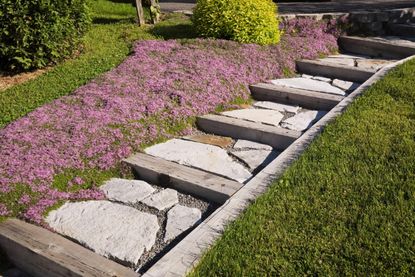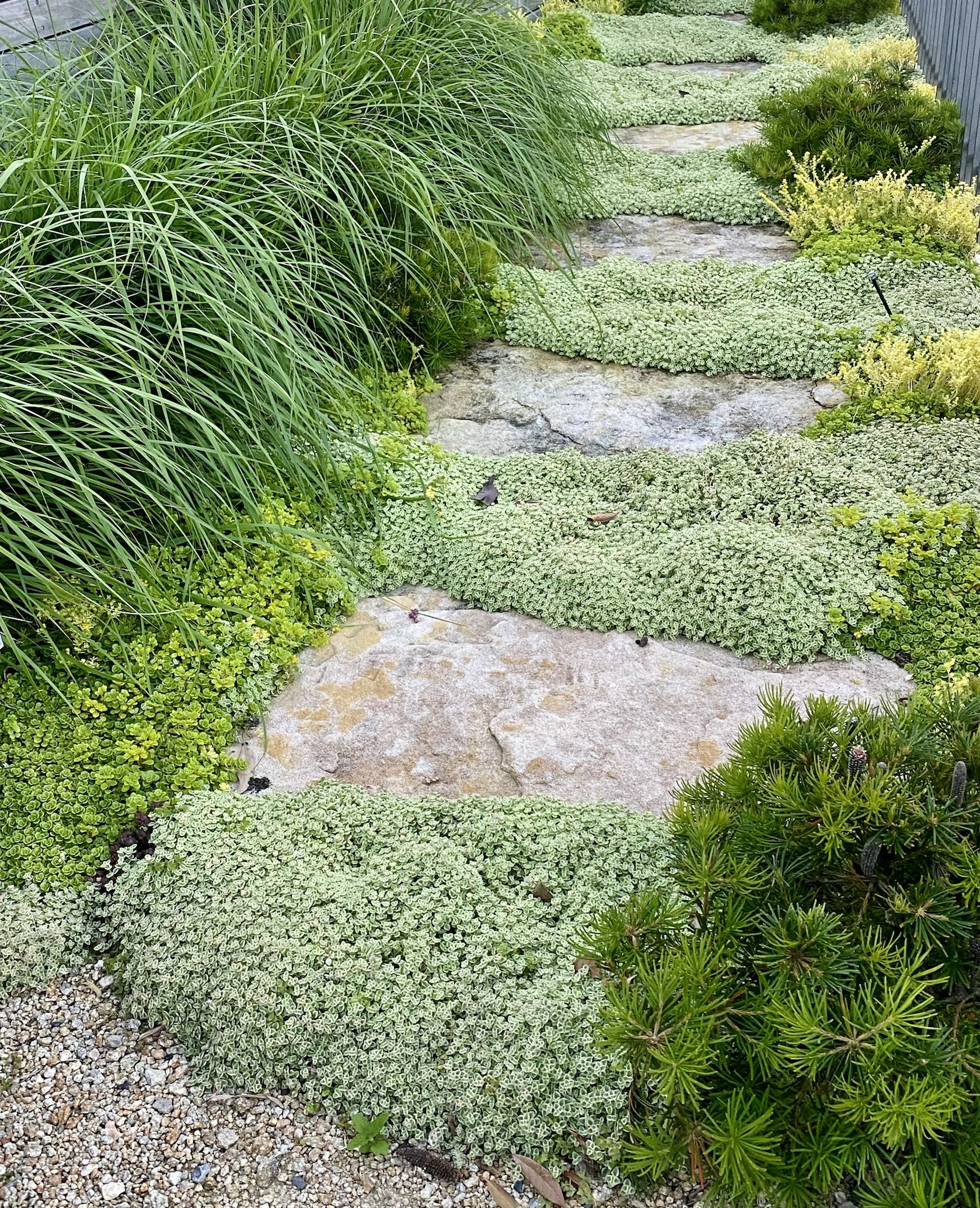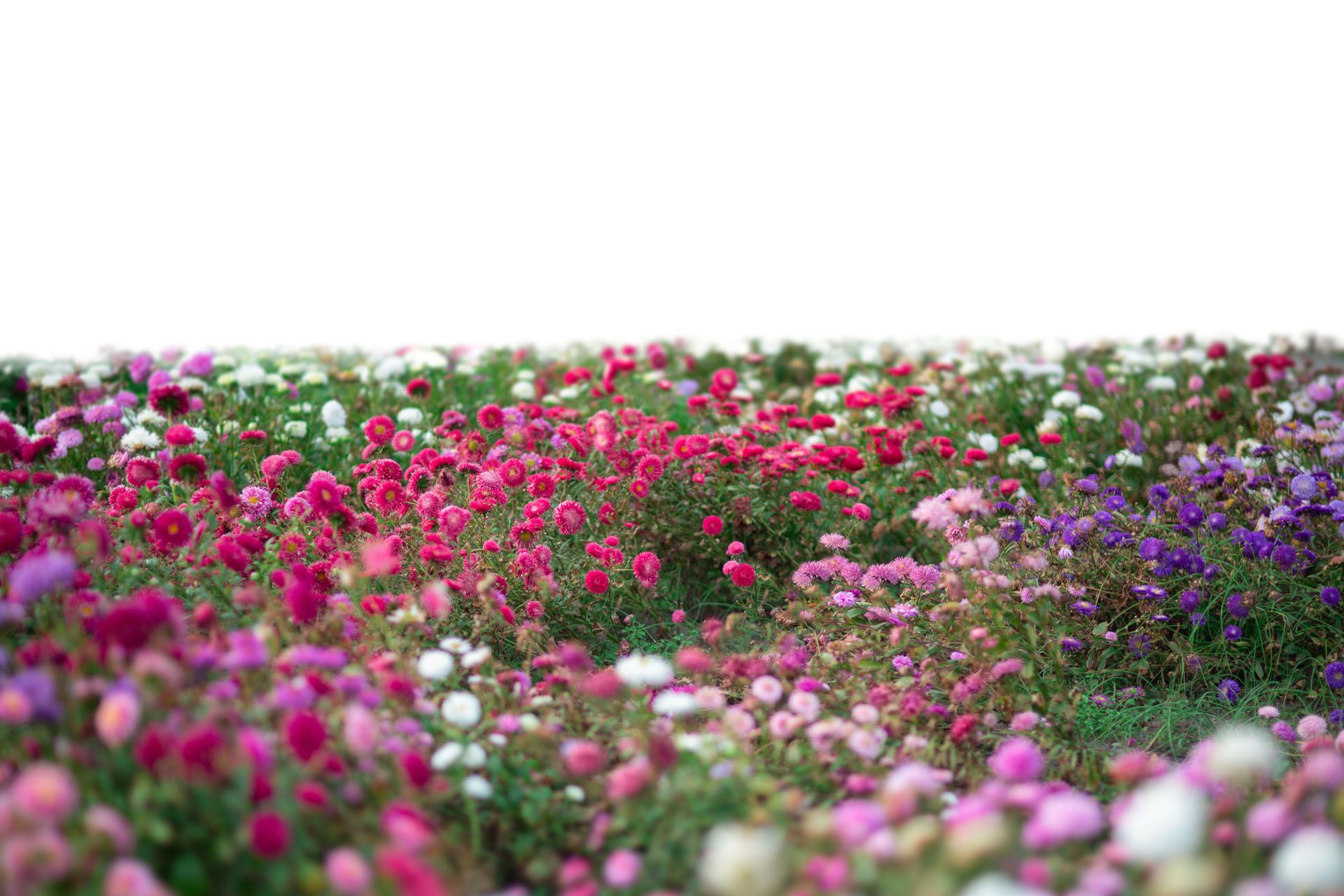These 7 grass alternatives will make a unique groundcover for a stylish, low-maintenance lawn
Take a different approach to your lawn with these stylish alternatives to grass that are guaranteed to inspire


While there are plenty of advantages of a luscious lawn of green grass, regular grass turf isn't the only option out there. If you want to break from tradition with a more unique and eye-catching lawn, there are all sorts of alternative groundcovers to choose from, and most of them are far more low-maintenance than grass, too.
Alternative groundcovers have been having a bit of a moment in the landscaping world. From the clover lawn trend to colorful tapestry lawns, many of us are favoring more unusual plants over standard grass. Besides offering a more textured or colorful appearance, they can be cheaper than turf, more eco-friendly, and an overall healthier choice for a backyard.
The difficulty comes in knowing what options are out there and which are suitable for your garden. Fortunately though, we have some expert gardeners on hand to help guide your decision. If you're ready to shake up your lawn this summer, here are some stylish alternatives to grass that are guaranteed to inspire.
1. Clover

Last summer clover lawns took off as a gardening trend, and if you still want a luscious green feel on your lawn, they really are one of the best alternatives to grass. Besides being a far cheap and more low-maintenance lawn option, they're also far prettier too.
'Clover plants make good grass alternatives due to their hardy nature, requiring less mowing and water than typical grass species,' explains Jeremy Yamaguchi, lawn expert and owner of Lawn Love. 'Clover lawns create thick, lush carpets of green foliage and they also produce white flowers and attract beneficial insects such as bees and butterflies.'
From a practical point of view, these types of lawns can also provide natural nitrogen fixation for your soil, helping other plants in your garden to grow healthily. 'To plant clover, sow seeds in spring or fall directly into the soil,' adds Tony O'Neill of Simplify Gardening. 'Clover thrives with regular watering until it's well-established, after which it can tolerate periods of drought.'
2. Creeping thyme

If you want to introduce some color to your lawn, as well as a sweet-smelling scent to greet you every time you walk across your backyard, creeping thyme makes a great alternative to grass. While not a close imitation by any stretch, this fragrant perennial herb will tolerate a range of conditions and create a carpet of purple petals on your lawn.
It might not be as soft as grass, but thyme makes a great walkable groundcover for pathways or high-traffic areas of your garden since you don't have to worry about it wearing down like you do with grass. 'Plant thyme by placing small plants or cuttings into well-drained soil in early spring,' Tony suggests. 'It prefers full sun but can tolerate partial shade, and once established, it's drought-tolerant and only needs occasional watering during dry spells.'
3. Moss

Typically moss is something we try to rid our lawns of, but if you don't fancy polluting your lawn with harsh chemicals in a battle to banish it, you could embrace moss as a groundcover instead. If you're looking to keep your lawn green but add a bit of extra cushioning, it's one of the best alternatives to grass.
'If you have a shady garden, moss makes an excellent and unique choice,' notes Tony. 'Its velvety green carpet brings a mystical aesthetic, requiring far less water and no mowing like grass. Moss can be established by transplanting patches into the desired area or by making a moss slurry (blended moss with buttermilk) and applying it to the lawn. Water it regularly until it's well established, and then sit back and watch it thrive in the shade.'
4. Carex (Sedges)

Strictly speaking, carex is still technically a type of grass, but its taller, fluffier tufts can turn your lawn into a sea of soft green foliage. It's also far more environmentally and wildlife gardening friendly since they need little water and no fertilizer when planted in their native regions.
'Carex, also known as sedges, are elegant bunching plants with blade-like foliage,' Jeremy explains. 'They’re quickly gaining popularity as an easy-care turfgrass alternative, and there's a tremendous variety (over 2,000 species globally), so you can pick the one that best fits your yard’s needs.'
For a sedge that will fill out your entire lawn, Jeremy suggests the shade-loving Pennsylvania sedge. 'Thriving in the Eastern US, it can be kept as an unmown lawn of six to seven inches or mowed at three to four inches,' he says. 'If you live on the West Coast and have sandy soil, evergreen sand dune sedge is an excellent option while Texas sedge is a popular choice for Texan homeowners with shady lawns and dry to moist soil.'
5. Dichondra Repens

If you're looking for a more low-growing groundcover that makes a lusciously green landscaping idea for your lawn, Dichondra Repens - commonly known as kidney weed due to its kidney-shaped leaves - is a great choice. The warm-season perennial grows best in small gardens as opposed to sprawling lawns, but it has the advantage of being a no-mow lawn substitute.
'Aesthetically, it has a delicate, cascading nature that softens hardscapes, and practically, it's a great solution for those tricky shady spots where grass struggles,' says Tony. 'You can plant Dichondra from seeds or plugs in well-draining soil which should be kept moist until established. Regular watering and a feed in the spring will keep it looking lush and green.'
6. Sedum

For another low-maintenance garden idea, sedum is an excellent alternative to lawn grass. Also known as stonecrop, this mat-forming groundcover is often used in between pathway paving stones or among rockeries thanks to its hardy nature.
As Tony notes, sedum is an expansive family of succulent plants known for their water-storing leaves and star-shaped flowers.' Varieties like Sedum album or Sedum sarmentosum are ideal as ground covers,' he says. 'Sedum provides a unique aesthetic with its succulent leaves and bursts of colorful flowers, and practically, it's extremely hardy, drought-resistant, and can tolerate foot traffic.' To plant it, he suggests placing cuttings or small plants into well-drained soil during spring or autumn.
7. A tapestry lawn

Last but not least, if you want your lawn to offer a burst of bright colors, a tapestry lawn might be for you. They're a type of ground-cover foliage made up of various low-growing perennials that create a patchwork-like collage in your backyard, making them great for adding variety and diversity to your outdoor space.
While a little more unusual, tapestry lawns are growing in popularity. 'Not only are they more colorful, more visually intriguing, and more eco-friendly than grass, but they're also more low-maintenance too,' notes Jeremy. 'They don’t require frequent mowing or general maintenance, and they typically require much less watering.'
You can choose any time of low-growing plant you like to make up a totally unique tapestry lawn, but Jeremy suggests choosing ones that are native to your area and non-invasive. 'You also want your selection of plants to all have similar water, light, and humidity requirements,' he adds. 'The only major downside to this type of lawn is that it is not well built for much foot traffic.'
Ready to wave goodbye to your grass? Try these alternatives

Price: $17.10
Quantity: 16 Oz

Price: $4.99
Non GMO

Price: $19.97
Covers 200 sq foot
Be The First To Know
The Livingetc newsletter is your shortcut to the now and the next in home design. Subscribe today to receive a stunning free 200-page book of the best homes from around the world.

Lilith Hudson is the News Editor at Livingetc, and an expert at decoding trends and reporting on them as they happen. Writing news, features, and explainers for our digital platform, she's the go-to person for all the latest micro-trends, interior hacks, and color inspiration you need in your home. Lilith discovered a love for lifestyle journalism during her BA in English and Philosophy at the University of Nottingham where she spent more time writing for her student magazine than she did studying. After graduating, she decided to take things a step further and now holds an MA in Magazine Journalism from City, University of London, with previous experience at the Saturday Times Magazine, Evening Standard, DJ Mag, and The Simple Things Magazine. At weekends you'll find her renovating a tiny one-up, one-down annex next to her Dad's holiday cottage in the Derbyshire dales where she applies all the latest design ideas she's picked up through the week.
-
 How to Thaw a Frozen Pipe — Learn Everything You Need to Know in 5 Minutes With This Guide
How to Thaw a Frozen Pipe — Learn Everything You Need to Know in 5 Minutes With This GuideWinter storm caught you off guard? We asked an expert — just how do you thaw a frozen pipe?
By Hugh Metcalf Published
-
 The 12 Very Best Silk Bedding Pieces — As Our Style Editor Says: 'It's What Dreams Are Made Of!'
The 12 Very Best Silk Bedding Pieces — As Our Style Editor Says: 'It's What Dreams Are Made Of!'Slumber in lustrous luxury with the very best silk bedding sheets, duvets, pillowcases, and more — your sleep score will thank us later
By Julia Demer Published

